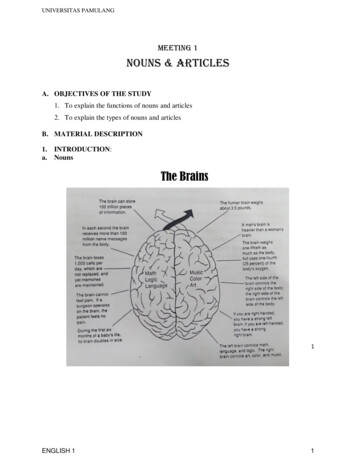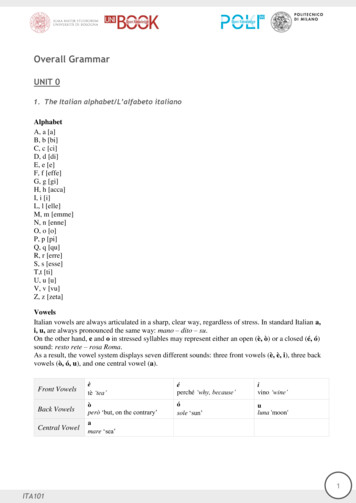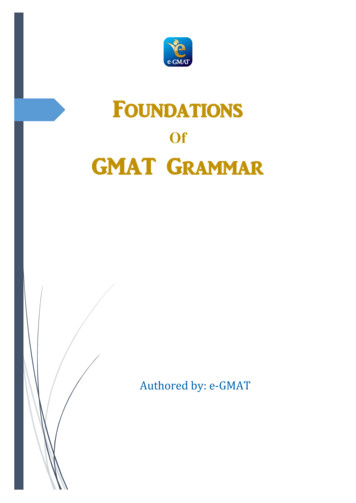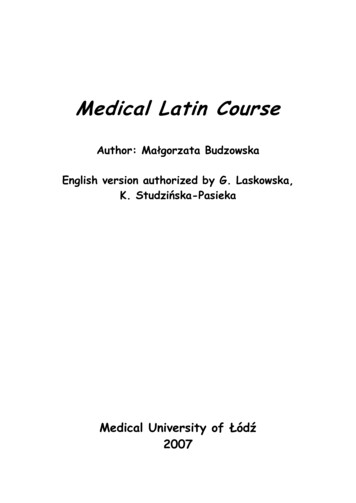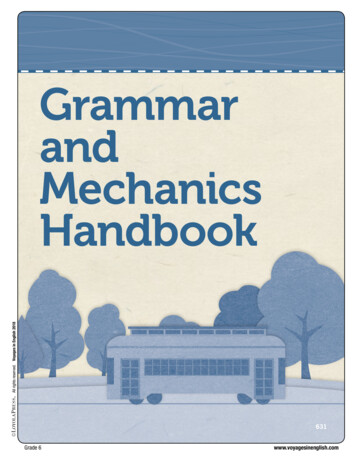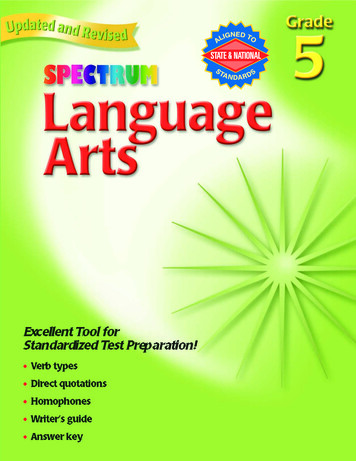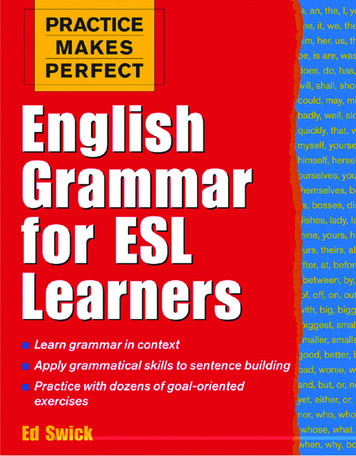
Transcription
Unit - ctionDefinition of NounsNoun and Noun PhraseKinds of Nouns1.4.1 Proper nouns1.4.2 Common nouns1.4.3 Collective nouns1.4.4 Material nouns1.4.5 Abstract nounsNouns: Countability1.5.1 Coun table nouns1.5.2 Uncountable nounsNouns: Gender1.6.1 Masculine and Feminine forms1.6.2 Common/dual genderConclusion1.8Unit End Questions1.51.61
1.0 ObjectivesThis unit will give you a fairly good idea about the most common of the parts ofspeech – Nouns. In Hindi you call them सं7ा1.1 IntroductionNouns are naming words. Every language has its own set of nouns and the list isopen ended i.e. newer nouns one added to the older ones with the changing times.1.2 Definition of NounsA Nouns is the name of a person place or thing. A thing includes a quality (fear) amaterial (gold), a collection (herd, army), a state (adherence) and an action (cheat,mock, movement)1.3 Noun and Noun PhraseA noun is often called a' noun phrase. A noun phrase can be a single-word noun:Teachers love their pupils. (noun phrase: teacher)But a noun phrase is usually longer than a single word because it consists of anadjective or a determiner plus a noun.A good teacher loves his pupils. (noun phrase: a good teacher)1.4 Kinds of NounsNouns can be classified into five kinds:1.Proper nouns2.Common nouns3.Collective nouns4.Material nouns5.Abstract nouns2
1.4.1 Proper nounsA proper noun is the name of a particular person or thing, i.e. a name used for anindividual person or place, river, or mountain etc.:Mary, Rahul, Godavari, India, Everest1.4.2 Common nounsA common noun refers to any and every person or thing of the same kind or class,not to a particular person or thing:cow, dog, girl, boy, man, womanCommon nounsProper nounsgirlLathadogRovermanAslam1.4.3 Collective nounsA collective noun is the name of a collection, group of people, or things of thesame kind: class, team, government jury, federation1.4.4 Material nounsA material noun is the name of a material, substance, or ingredient things are madeof. They can be articles of food or drink as well:iron, copper, steel, gold, coal, silver, rice, wheat, milk, water, tea, sugarNote: A material noun is a type of common noun but a distinction is made betweenthe two. A common noun is usually a countable noun but a material noun is anuncountable noun.The cow gives us milk.Cow is a common noun (countable), but milk is a material noun (uncountable).1.4.5 Abstract nounsAn abstract noun is the name of a quality, state, or concept:beauty, sweetness, childhood, love3
Note: Concrete nouns are names of material things, i.e. things having a materialform, shape or size. Abstract nouns are the names of qualities found in variouskinds of objects. Since they have no material form, they cannot be seen or touched.We can know of them only through our mind:Concrete nounsAbstract nounssugarweetnessbookbeautymilkhatredPatnafearWe can see sugar but cannot see sweetness, so sugar is a concrete noun andsweetness an abstract noun. In short, concrete nouns refer to physical propertiesand abstract nouns to mental roperties.1.5 Nouns: CountabilityNouns are of two kinds from the viewpoint of countability:a) Countable nouns b) Uncountable nouns1.5.1 Cou table nounsNouns that can be counted are called countable nouns:a bookone booktwo booksan eggone eggtwo eggsGenerally a noun used in answer to the question how many? is a countable noun:How many films did you watch?I watched six films.How many flights are there from here to Delhi?There are only two flights.Note: Common nouns and collective nouns are by and large countable.1.5.2 Uncountable nounsNouns that cannot be counted are called uncountable nouns:4
milk, water, ink, sugar, butter(not, a milk, one water, two sugar)A noun used in answer to the question how much? is an uncountable noun.When we want to refer to the quantity of these items we use values ofmeasurement which are countable:How much milk do you need?We need a litre of milk.Note: a)Material nouns and abstract nouns are uncountable. So are propernouns, though they can be used as countable nouns in specialsituations:There are two Indias, the rural and the urban.b)Certain nouns can be used both as countable and uncountabledepending on the context.UncountableCountableI prefer chicken to fish.These chickens are lovely.Petrol catches fire easily.Shall we make a fire out here?1.6 Nouns: GenderGender is of four kinds:Masculine (denotes male)Feminine (denotes female)Common (denotes both male and female)Neuter (denotes neither male nor female)Masculine er
bullcowdiplomattableNote: The words masculine and feminine can be used as adjectives to describe thelooks or qualities of human beings. In this sense masculine means: having thecharacterstics of a man, so it can be used of a woman or girl as well.The lady standing in the centre has masculine looks.Similarly with feminine. Notice that in this sense masculine/feminine indicatescharacteristics or attributes, not sex.1.6.1 Masculine and feminine formsThe feminine of nouns is formed in two ways:i) by adding ess to the masculine formii) by adding she/girl/woman to the masculine formi) By adding ess to the masculine rdesstigresswaitressNote: a) English has only a small number of feminine forms (noun ess).Professional activities are often referred to in the common gender.The feminine forms authoress, poetess, directress, inspectress are no longer in use.She is the director of this institute. (not, directress)She is an inspector of police. (not, inspectress)b) The feminine form of hero is heroine.6
ii) By adding studentwoman ateswomanBut in many cases, the feminine form is not derived from the masculine form. Inthe examples listed below, the feminine form is a totally new word, not related tothe masculine form owgentleman khennephewneicecoltfi beewizardwitchfathermotherfoxvixenfriar/monk nunmon/dualgender7
1.6.2 Common/dual gender1) Nouns denoting professionMost of the nouns denoting profession/occupation are in the common eermusicianscientistauthorfoolneighbour lmagicianprincipalwriterdancertrlagistrate professor1.9 ConclusionNow you have a basic idea about the kinds of nouns and gender.1.10 Unit end Questions1.Name any ten nouns around you and classify them accordingly.2How are feminine forms formed in English. Give examples.8
Unit – tivesIntroductionDefinitionKinds of Pronouns2.3.1 Personal pronouns2.3.2 Possessive pronouns2.3.3 Reciprocal pronouns2.3.4 Demonstrative pronouns2.3.5 Reflexive pronouns2.3.7. Relative pronouns2.3.8 Interrogative pronouns2.3.10 Indefinite pronounsPronouns: NumberPronouns: GenderPronouns :PersonsSummaryExercises2.0 ObjectivesIn this unit we shall discuss Pronouns as used in English9
2.1 IntroductionPronouns are what you understand as सवJनाम in Hindi. They are not open ended.The list of pronouns in every language is limited.2.2 DefinitionPro means 'for' or 'acting as.' A pronoun is used as a substitute for a noun or a nounphrase. In other words, it has all the characteristics of a noun: it can function as asubject/object/complement in a sentence.A pronoun is used to avoid the repetition of nouns or noun phrases:1.Suresh went to the market because Suresh wanted to buy a pen.i.e. Suresh went to the market because he wanted to buy a pen.2.Walking is a form of exercise. Walking is easier than swimming.i.e. Walking is a form of exercise. It is easier than swimming.But a pronoun is different from a noun in that it cannot take a premodifyingadjective nor can it take a determiner or a prefix/suffix. The form of a pronoun isfixed.2.3 Kinds of PronounsThere are nine kinds of pronouns:i)Personal Pronounsii)Possessive Pronounsiv) Demonstrative Pronounsv)Reflective Pronounsvii) Relative Pronounsviii) Interrogative Pronounsix) Indefinite Pronouns2.3.1 Personal pronounsI, we, you, he, she, it, they10
These seven pronouns are called personal pronouns. On the basis of their role in aspeech act, these can be divided into three:First Person, Second Person, Third Person2.3.2 Possessive pronounsmy, our, your, his, her, their, its (determiners)mine, ours, yours, his, hers, theirs, its (predicative use)They are used to express ownership/possession/relationship.Determiners are followed by a noun.This is my room.The possessive pronoun in its predicative use cannot be followed by a noun.We don't say:This is mine room.We say:The room is mine.Note: Its is always used as a determiner, never as a predicative.This is a lock and that is its key. (not, . that key is its.)2.3.3 Reciprocal pronounseach other, one anotherThese are used to express mutual/reciprocal relationship:They love each other/one another.Like any other pronoun, each other and one another have no intrinsic reference;therefore they have to have an antecedent. But unlike other pronouns, these cannotnormally appear as the subject of a main clause because the antecedent should bein the sentence itself. Typically these occur as object of a verb or a preposition in asentence that has a plural subject.1.No two artists approve of each other's works.But we cannot say:11
2.If there are two children of the same age it is always good to put them in thesame class. Each other can help in doing the homework.But we can say:The children can help each other in doing the homework.Even though there are enough contextual clues in (2) as to the antecedent of eachother the sentence is not possible.Note: Traditional grammar makes a distinction between each other and oneanother. It requires that each other be used of only two people/things and oneanother of more than two. In current English both are used interchangeably, with aslight preference for each other.2.3.4 Demonstrative pronounsthis, that, these, thoseThey are used to point to (demonstrate) people or things they stand for:1.This is our new house.2.That is the bridge built by the British.Demonstrative pronouns have number contrast:thisthesethatthoseThe basic function of demonstratives is to indicate the nearness or distance of theperson or object referred to, from the speaker.Some of the uses of demonstrative pronouns are shown below:a)When pointing:This is my brother, Ravi.That is his new car.b)When a specific category is implied:Those who apply late will not be considered.c)When there is a reference to a previous statement or a statement thatfollows:12
This is what I told them.That is my opinion on the matter.Note: Difference between it and thisIt is a personal pronoun, whereas this is a demonstrative pronoun. As ademonstrative pronoun this indicates nearness and also identifies a person or thing.The use of it does not convey these shades of meaning, so this is preferred to it formaking a formal announcement or introduction:This is All India Radio giving you the news. (not, it)Mum, this is Iaya, my friend. (not, it)In an answer, however, it is preferred to this when a contracted form is used.What's this?It's a new electronic device. (not, this)But when a contracted form is not used, this is okay.What is this? This is a new electronic device.2.3.5 Reflexive pronounsForm:A reflexive pronoun is formed by attaching self/selves to the objective form of thepronoun:myself, ourselves, yourself/selves, himself, herself, themselves, itselfa) A reflexive pronoun is used as a substitute for a noun in the objective case i.e.,as a direct object:Govind saw Govind in the mirror.Govind saw himselfin the mirror.This is used to avoid an awkward construction 'Govind . Govind' .Gayatri laughed at Gayatri.Gayatri laughed at herself.13
Note: .Reflexive means 'bent back', i.e. 'bending the subject back to the subject.' Areflexive pronoun is used when the subject and the object refer to the same personor thing. This can be seen from the agreement between the subject and thereflexive object:I saw myself in the mirror.We dressed ourselves in the kitchen.You sent yourself a birthday card.They wrote themselves a 'Thank you' note.He hurt himselfwhile playing.She taught herself the piano.One should avail oneself of this chance.b) It can be used as an indirect object as well:Sujatha made herself a new dress.Raghu gives himself airs.2.3.7. Relative pronounswho, whom, which, what, thatA relative pronoun relates or refers back to a noun or pronoun called its antecedent.It also joins clauses. So it is a pronoun as well as a conjunction. Relative pronounsintroduce relative clauses and noun clauses:Those who live in glass houses shouldn't throw stones.I don't know who is standing at the gate.Which is used also as a sentence relative pronoun to introduce the relative c in asentence:They eat snakes, which is unusual.2.3.8 Interrogative pronounsWho, whom, whose, which, what14
The forms of relative pronouns and interrogative pronouns are identical, but theirfunctions are different: the former join clauses, the latter ask questions.a) Who can come as the subject or as the object in a clause. Here who refersonly to persons, not to things:Who discovered America? (as subject)Who did you invite for lunch? (as object)Who are you talking about? (as object of the preposition)In current English, whom is rarely used as the object; who is the preferredform.b)Whose is the possessive form of who; it can stand for both animate andinanimate nouns in interrogative expressions.Do you know whose book won the award this year? (refers to author)I borrowed a book from the library whose pages are all torn. (refers tobook)c)Which is used for both people and things when there is an implied choice orselection:Which card game do you like to play?Which teacher do you like best?d)What as subject or object is used to refer to things only:What is in your pocket?What's wrong with you?Note: a) Who is used for asking questions about a person's name, what forseeking information about a person's profession.Who is that gentleman talking to your father? He is Mr Reddy.What is he? He is an artist.b) Which presupposes a set and the person is being asked about his choice.What, on the other hand, does not presuppose any set and there is no choiceimplied.15
Which do you want?What do you want?2.3.10 Indefinite pronounsThe red one.Some coffee.Indefinite pronouns constitute a heterogenous set. One can go about classifyingthem differently using different criteria.A) Universal pronouns:each, every, allEach refers to two or more people or things, whereas every refers to three or more.Further, each presupposes a set (supplied by the context), every does not.Rajeev walked into the room and gave a sweet to everyone (not, each)Both each and every take of-constructions following them. So does all.All can occur immediately before a noun. Therefore it is more like a determiner.At times a definite article can intervene between all and the noun.All the girls want to imitate Karen.Each of you should attend the function.Everyone of them came to see me in hospital.B) Assertive pronouns:a)b)There are five sub-classes in this:much,manymoreMilkMorehatsmostMosylittle, less, least, few, fewer, fewestLess goes with uncountable nouns and fewer with countable nouns.Occasionally, less can be found with count nouns, too. Expressionsdenoting periods of time, sums ,of money etc. take less.There is less orange juice in my glass.There are fewer public holidays this year.16
c)d)e)several, enoughSeveral occurs with plural countable nouns only. Enough can occur withboth countable and uncountable nouns. Enough, unlike several, can precedeor follow the head noun.Hanif and I met and spoke to several craftspersons at the fair.Have you packed enough food for a day?Have you packed food enough for a day?oneThe use of one as a pronoun is typical of British English. In AmericanEnglish his is used in place of one's.One should love one's neighbour.One should not think too much of oneself.In question tags we/you is preferred to repeating one.One cannot live all alone, can we/you? (not, one)One/ones can substitute for a countable noun.This mirror has cracked. I need to buy a new one.These grapes are sour. I like sweet ones.One can be premodified by the, that, this and which.I have read a number of stories, but this is the one I like best.I don't fancy this model, can I have that one?Which one? The one in the corner?One/ones is usually left out after these/those/either/neither/firstllastlnext.These cars are smaller than those. (not, those ones)The last to arrive was the bl ind man. (not, last one)Here are two shirts. You can take either. (not. either one)someone, somebody, somethingSome usually goes with positive statements/questions.17
Something must be done before it is too late.Can someone help me with accounts?I hope somebody picks up the phone.C)Non-assertive pronouns:a) anyone, anybody, anythingAny, unlike some, has some special occurrence properties. It does not occurwith positive statements unless there is a modal element like can/will. Anegative also can licence any.The citizens will not believe anything. (not, The citizens believe anything).I can challenge anybody.b)eitherEither as a pronoun refers to one out of a set of two. Note that either isalways singular.Eitheryou make up your mind quickly, or we leave you and go.Either of the two proposals is acceptable to me.D) Negative pronouns:a) no, no one, nobody, none, nothingNo can precede a 'noun, therefore it is like a determiner.Madhuri showed no interest in the new film.The rest of the n- series have only nominal function. These generally takean affirmative verb; they do not allow a not in the sentence.The police did nothing to control the mob.(not, The police could not do nothing.)There are certain varieties of non-standard English where a double negativeis common.b) neither18
Neither is the negative counterpart of either. It is always used in thesingular. It can come before a noun.Neither of the allegations is true.Neither allegation is true.2.4 Pronouns: NumberLike nouns, pronouns too, have number. But the number system of pronouns isdifferent from that of nouns because an s is not added to pronouns to turn them intoplural. The singular and plural forms of pronouns are fixed.singularpluralI, me, my, mine, myselfwe, us, our, ours, ourselvesyou, your, yours, yourselfyou, your, yours, yourselveshe, his, him, himselfshe, her, hers, herself they, them, their, theirs,themselvesit, its, itself, one, oneselfthis, that, much, little these, those, ones, both,many, someeach, either, neither, few, each other, oneanothernone, no one, someone, anyone, everyonesomebody, nobody, anybody, everybodysomething, nothing, anything, everythingNote: you, all, any, some, none, who, which and that can be used in both numbers.You are a clever fellow.All is not lost.You are brave men. .All are well here.(Thou, the singular second person pronoun is archaic.)2.5 Pronouns: GenderGender is of four kinds:i) Masculine19
ii) Feminineiii) Commoniv) NeuterThe gender system of pronouns is different from that of nouns because a suffix likeess is not used to mark gender distinctions. The gender of pronouns is fixed.i)Masculine pronounshe, him, his, himselfii)Feminine pronounsshe, her, hers, herselfiii) Common gender pronounsI, we, you, theyPersonal Pronounsmine, ours, yours, theirsPossessive Pronounsmyself, yourself, ourselves, themselves Reflexive Pronounseach other, one anotherDistributive Pronounseach, either, neithereverybody, nobody, anybodyIndefinite Pronounssomebody, everyone, nooneanyone, someone, one noneho, which, what, that,Relative Pronounswho? which? what?Interrogative Pronounsiv) Neuter gender pronounsit, its, itselfanything, nothing, something, everything2.6 Pronouns :PersonsPerson is a grammatical category which has three divisions:20
The first person refers to the person speaking or writing (I, we), the second personto the person addressed (you) and the third person to the person spoken or writtenabout (he, she, they). In a speech situation the first and second person arenecessarily present, the third person mayor may not be present.i) First personI, me, my, mine, myself,we, us, our, ours, ourselvesii) Second personyou, your, yours, yourself, yourselvesiii) Third Personhe, his, him, himself,she, her, herself,it, its, itself,they, them, their, theirs, themselves2.7 SummaryYou have been given a detailed understanding of the pronouns in English in thisunit.2.8 Unit End QuestionFill in the blanks with the right alternative:i) She doesn't obey parents. (his, her)ii) It is who has broken this chair. (he, him)iii) He is not such a man can help us. (who, as)iv) I don't know the man is standing there. (who, which)v) One shouldn't betray friends. (one's, his)vi) of the two sisters is married. (none, neither)vii) of the two boys will get a prize. (anyone, either)21
viii)of the two girls has short hair. (each, everyone)ix) Everyone of the guests has taken seat. (his, their)x) He and I believe in doing work sincerely. (my, our)xi) My watch broke yesterday is now useless. (that, which)Choose the right alternative and fill in the blanks:i) Who you food and money? (gives/does give)ii) What the accident? (did caused/caused)iii) What is she? She is . (Mary/a nurse)iv) He acquitted as a statesman. (well/himself well)v) is the tallest girl in the class? (Which/What)vi) is he speaking to? (Who/Whom)vii) he gone yet? (has/hasn't)viii)Do you know who ? (she is/is she)ix) They are looking at . (he/him)x) Who is he? He is . (a teacher/Rakesh)III. Correct these sentences:1. My father, that lives in France has sent me a watch.2. It are they who create problems everywhere.3. I haven't yet read the book who is lying on the shelf.4. She is 0 e of those who does what she says.5. One can't live all alone, can one?6. They each wants to get a medal.7. This is a fan and that is it's switch.8. Do you know as to when will Jennifer get back?9. Everyone of these two boys was rewarded.10. I am the man who have won a prize.22
11. I think foolish to tease a snake.12. This is mine own car.13. He always prides on his wealth.14. He addressed to the chair.15. Which colour is gold?IV. Put a tick (V) against the correct )a)b)a)b)c)a)b)c)a)b)It was Anil who helped me.It was Anil that helped me.It is Shweta whom I want to see.It is Shweta that I want to see.This apple is green. I want red one.This apple is green'. I want a red one.Look at the boy who is in shorts.Look at the boy that is in shorts.He is the greatest thinker that was ever born.He is the greatest thinker who was ever born.They eat snakes, which is nauseating.They eat snakes, which are nauseating.A girl who has short hair she looks like a boy.A girl who has short hair looks like a boy.A girl that has short hair looks like a boy.They enjoyed last night.They enjoyed themselves last night.They enjoyed themselves a party last night.It is BBC giving you the news.This is BBC giving you the news.23
Unit – 3Adjectives and tionDefinitionKinds of Adjectives3.3.1 Adjectives of quality3.4 Degrees of Comparison3.4.1 Comparative degree3.4.2 Superlative degree3.5 Comparatives and Superlatives3.5.2 Comparison: structure3.6 Determiners3.6.1 Categories of Determiners3.7 Differences between Adjectives and Determiners3.8 Determiners: Usage3.9 Summary3.10 Exercises3.0 ObjectivesIn this Unit we shall give details about Adjectives. We shall also describe modernEnglish grammar entity of Determines and how they differ from Adjectives.3.1 IntroductionAdjectives in English are equivalent of िवशेषण in Hindi. However, Hindi has so far,no exclusive entity of Determiners.24
3.2 DefinitionAdjective says something more about a noun. An adjective can take an adverb ofdegree (intensifier) like too/very. It has comparative and superlative forms as well.Adjectives in English are not affected by number or gender or case because they donot have to agree with the noun they modify.3.3 Kinds of AdjectivesAdjectives are of five kinds:3.3.1 Adjectives of qualityblack, white, long, shortgood, bad, hot, coldThey describe the shape, or size, or colour etc. of a person or thing.Milk is white.Today is a cold day.Fire is hot.Proper adjectivesIndian, AmericanRoman, ElizabethanThese are formed from proper nouns, particularly from names of geographicalplaces (continents, countries, states). Adjectives like these describe origin orsource:Indian goods, Japanese toys3.4 Degrees of ComparisonA significant formal feature of attributive adjectives is that they can be graded.This is known as degrees of comparison. This is a property adjectives share withadverbs.There are three degrees of comparison:25
i)positiveii)boldsweetlong3.4.1 Comparative iveboldestsweetestlongestAn adjective in comparative degree is normally followed by than.1. Tom is taller than John.2. She is older than him.3. This picture is more beautiful than that one.ii)Comparative form of comparative form of is used in the constructionthe comparative form of the two:1. He is the wiser of the two.2. This is the better of the two.iii) Comparative form toto is used with Latin comparatives1. He is junior to me.2. She is senior to him.iv) Preferable toto is used with preferable as well:1. Fish is preferable to red meat.2. Honey is preferable to sugar.Note: a)preferable is not used with more.not Fish is more preferable to red meat.b) than noun/pronoun (object form)26
In this construction than is a preposition used before a noun/pronoun to expresscomparison between two people or things. Since than is a preposition here it takesa pronoun in the object form:1.He is taller than me.2.He is older than her.3.She is richer than him.In this construction purists used to insist that the pronoun following than must bein the subject form.e.g. 'He is taller than I'This is now considered archaic. In current English, the objective form is preferredin both formal and informal usage.c) than noun/pronoun (subject form)In this construction than is a conjunction used after a comparative adjective/adverbto introduce an adverb clause of comparison, so than takes a pronoun in the subjectform:She loves her more than I do (love her).She is much better rcday than she was yesterday.He earns much more than she (does).She works harder than he (does) .3.4.2 Superlative degreeSuperlative degree is used in the structure the superlative of/in/on.This construction is used to compare more than two people or things:1.This is the best offer of all.2This is the oldest church in India.3Everest is the highest peak on earth.Note: a) In this construction we can't use,all other, any other, anyone else, anybody else, anything else27
not She is the tallest of any other girls.b) of is used with people or things and in and on with place:She is the best of the candidates.He is the richest man in the village.c) the is obligatory before the superlative form of the adjective.1.January is the coldest month.2.This is the safest way.3.Philosophy is the most difficult subject to learn.d) However, most is used in the following without a definite article. Hereit is not a superlative; the meaning is that of the intensifier very.Rashid is most unhappy. (meaning, very unhappy)This is a most interesting story. (meaning, very interesting)ii) one of the superlative plural nounThis construction, too, is used to compare more than two people or things:1.Kalidasa is one of the greatest poets.2.jaisalmer is one of the hottest places in summer.Note: a) A plural noun is always used after the superlative:One of the brightest objects.One of the cheapest bags.3.5 Comparatives and SuperlativesFormatiomi) Adjective er/estAdjective of one syallable adder in the comparative form and est insuperlative lest
weetestii) Adjective r/stOne syllable adjectives ending in e add r in the comparative form andst in the superlative estiii) Double Consonant er\estPossotoveBigFatHotSadGladsSilmthiniv) i er/estIf a one- syllable adjective ends in consonant y, y is changed into i when er/est is added:positivecomparativeeasyeasierdrydrier29
holyholierfunnyfunnierhappyhappierBut vowel y is not changed into i:gaygayerv) Irregular tfurthesteldest(of people only)oldest(of people and efartherfurtherelderoldervi) Adjectives of more than two syllables form their comparative/superlative byadding more to the comparative form and most in the lmore beautifulmost beautifulintelligentmore intelligentmost inte
characterstics of a man, so it can be used of a woman or girl as well. The lady standing in the centre has masculine looks. Similarly with feminine. Notice that in this sense masculine/feminine indicates characteristics or attributes, not sex. 1.6.1 Masculine and fe
